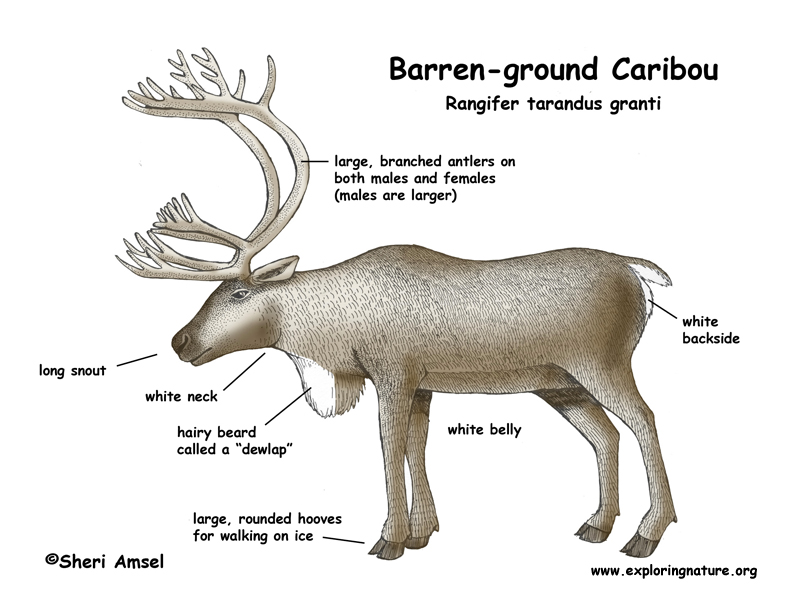

They are found in northern Europe, Asia, Alaska and Canada south into northeastern Washington and northern Idaho.
A male caribou can weigh up to 600 pounds and reach 7 feet long, while females reach 300 pounds. They have thick, brown fur with a white neck, backside and belly. They have a long nose and a hairy beard called a dewlap. They have long legs with big, rounded hooves that are covered with fur in the winter for walking on ice. Both males and females have antlers, but the males’ are larger and more branched. They are the only members of the deer family where the females have antlers as well as the males. *Reindeer and caribou are the same species, but there are several subspecies between them. They are more often called reindeer when they are kept by humans (captivity).
They travel in herds moving around in search of food. This traveling is called migration and can cover thousands of miles every year. Caribou can run up to 50 miles per hour. They can also swim when traveling on the wet summer tundra.
They eat grasses and sedges, lichens, mushrooms, birch twigs, and willow leaves.
They are hunted by grizzlies, black bears, cougars, wolverines, lynx, coyotes, and golden eagles.
Males will compete and even fight for females, collecting 5-15 in a group called a harem. Females are pregnant for 7-8 months (gestation). They have 1-2 calves. Calves can stand very quickly after they are born so they can keep up with the herd.
They can live up to 15 years in the wild. They are listed as endangered in some regions because of habitat loss. They are extinct is some of their original range.
Kingdom: Animalia
Phylum: Chordata
Subphylum: Vertebrata
Class: Mammalia
Order: Artiodactyla
Family: Cervidae
Subfamily: Capreolinae
Genus: Rangifer
Species: Rangifer tarandus
When you research information you must cite the reference. Citing for websites is different from citing from books, magazines and periodicals. The style of citing shown here is from the MLA Style Citations (Modern Language Association).
When citing a WEBSITE the general format is as follows.
Author Last Name, First Name(s). "Title: Subtitle of Part of Web Page, if appropriate." Title: Subtitle: Section of Page if appropriate. Sponsoring/Publishing Agency, If Given. Additional significant descriptive information. Date of Electronic Publication or other Date, such as Last Updated. Day Month Year of access < URL >.
Amsel, Sheri. "Caribou (Barren-ground and Woodland)" Exploring Nature Educational Resource ©2005-2024. December 13, 2024
< http://www.exploringnature.org/db/view/407 >


